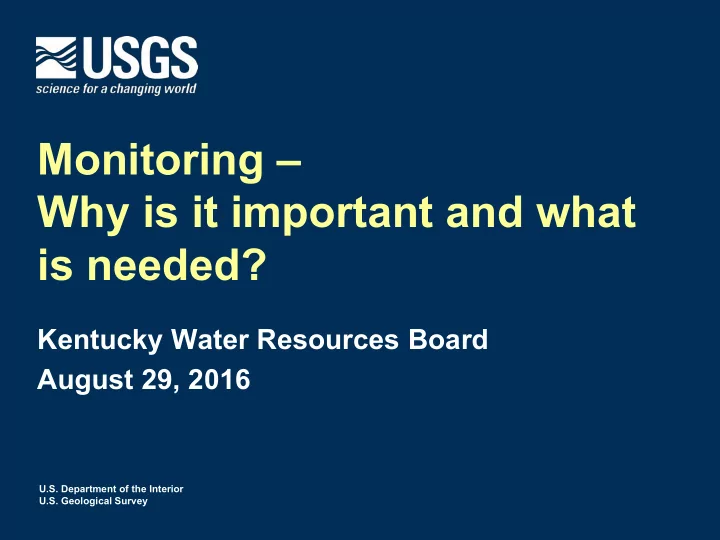

Monitoring – Why is it important and what is needed? Kentucky Water Resources Board August 29, 2016 U.S. Department of the Interior U.S. Geological Survey
Water – what are we working with? All water on earth – volume = ~332,500,000 cubic miles (mi 3 ) All liquid fresh water (over KY) - ~170 mi across or ~2,551,100 mi 3 All water in lakes and rivers (over GA) - ~ 35 mi across or ~22,339 mi 3
Lets first look at some KY information Projected Climate Changes at the Shawnee Hills Sites and Incorporation with Simulation of Soil-Water Storage Work conducted in by USGS, UK, NRCS, and Purdue using the WATER application developed by USGS and KDOW. Williamson T.N., Lee B.D., Schoeneberger P.J., McCauley W.M., Indorante S.J., Owens P.R. 2014. Simulating Soil- Water Movement through Loess-Veneered Landscapes Using Nonconsilient Saturated Hydraulic Conductivity Measurements. Soil Science Society of America Journal 78:1320-1331. DOI: 10.2136/sssaj2014.01.0045.
What does the data show? A longer growing season and more rain - but precipitation will likely occur largely in the winter.
What does that mean to KY (especially agriculture)? Increased demand (potential evapotranspiration) in times when the system is historically water limited (actual evapotranspiration). This would indicate that irrigation will likely be of greater importance and the ability to quantify / manage local water resources will be more critical.
As we develop our water resources... Plot shows groundwater budgets before and after development of the Gulf Coastal Plain aquifer system. The withdrawals from the aquifers have been balanced by increases in recharge to the aquifer system and decreases in storage and discharge from the aquifer system – note that one parameter alters the others. Figure modified from Williamson and Grubb, 2001
Water management is a concern in the Western U.S., but other parts of the Nation are experiencing issues as well… Groundwater has been the sole source of drinking water for about 8.2 million people in the Great Lakes watershed since ~1864. This long-term pumping has lowered groundwater levels by as much as 900’ in the sandstone aquifer underlying the Chicago area. Concern over how such pumping affected surface water in the Great Lakes region led to the reduction of groundwater withdrawals in much of the area. Water levels are recovering in some areas, however, declines continue in others (Grannemann and others, 2000 and Alley and others, 1999). http://pubs.usgs.gov/fs/fs-103-03/JBartolinoFS(2.13.04).pdf
We need adequate data to solve a basic water- budget equation in KY’s critical areas so we can manage water resources. Precipitation = Evapotranspiration (ET) + Streamflow (Q) + D Groundwater (GW) + D Soil Moisture (SM) + D Reservoir Storage (RSV) + D Diversions
Streamflow - USGS Real-Time Streamgages USGS operates approximately 15,000 sites nationally with real- time streamflow data. This national network allows local data to be quickly scaled-up to a regional or national context to assess conditions – but it may NOT be locally optimized for specific uses.
USGS IN-KY WSC has over 200 sites with real-time data in Kentucky USGS continually assesses the statistical strength of the network; we already see a loss of statistical strength in rural areas as static funding is shifted to urban areas to address changing priorities. Notably, gaps exist in the Western KY and the Cumberland River Basins. Gages are also used to compute estimates of GROUNDWATER RECHARGE and other related water-budget parameters.
Groundwater - KGS Making Progress Toward Improved Statewide Groundwater Monitoring and Research but there are significant gaps. Precipitation = ET + Streamflow + D GW + D SM + D RSV + D Diversions
Re-Establishing a Groundwater-Level Observation Network
Summary: KGS Activities to Improve GW Monitoring Began re-establishing statewide network of long-term water-level observation sites. Conducting focused groundwater research to better characterize the aquifer system in the Jackson Purchase Area. Conducting aquifer tests to enable better assessment of groundwater availability. Creating new webpages needed to enhance public access to groundwater data. Conducting targeted sub-regional groundwater-quality assessments.
Mesonet – Climate and soil-moisture data Precipitation = ET + Streamflow + D GW + D SM + D RSV + D Diversions
There are many issues related to water quality. Harmful Algal Blooms (HABs) is among the most recent but there is the Gulf Hypoxic Zone and many other issues. http://www.epa.gov/nutrientpollution/harmful-algal-blooms
1) What are the causes / effects of water-quality issues? Here, real-time continuous data is critical to determining these.
2) What’s coming into Kentucky and what’s going out? Estimates of nitrite plus nitrate ANNUAL loads About 16% contributing 100% contributing tributaries sources unknown unknown (Licking River site on-line but loads have not been computed yet) New Harmony, IN 110,000 MT/yr Greenup, KY Cannelton, IN Olmsted, IL Ohio River 64,100 MT/yr 128,000 MT/yr 314,000 MT/yr Spottsville, KY 15,800 MT/yr Alexandria, KY Paducah, KY 28,600 MT/yr
Real-time continuous nitrate data Green River at Spottsville, KY Daily Load = much greater CONTINUOUS STREAMFLOW AND NO 3 information about what’s happening in the basin Nitritie plus nitrate load 140.00 120.00 100.00 80.00 60.00 40.00 20.00 0.00 4/1/2014 5/1/2014 6/1/2014 7/1/2014
USGS “Super Gage” – what is it? Ohio River at Ironton, OH USGS Super Gages • Extensive equipment and real-time telemetry • Continuous “real-world” data • Data ties models to reality and improves accuracy • QA/QC = defensible data
USGS Super Gage Ohio River at Olmsted Lock and Dam
Current USGS Super Gage Locations Yellow – Real-time USGS Super Gage Red – USGS long-term NAWQA sampling sites
National Perspective – with real-time monitoring (8/26/2016) http://waterwatch.usgs.gov/wqwatch/
Future needs * Sites on all major river basins * Sustainable funding
Questions? Contact information: Peter J. Cinotto Deputy Director, Kentucky USGS Indiana-Kentucky Water Science Center 9818 Bluegrass Parkway Louisville, KY 40299-1906 Email: pcinotto@usgs.gov 502-493-1930 – office 502-493-1909 - fax https://profile.usgs.gov/pcinotto
Recommend
More recommend